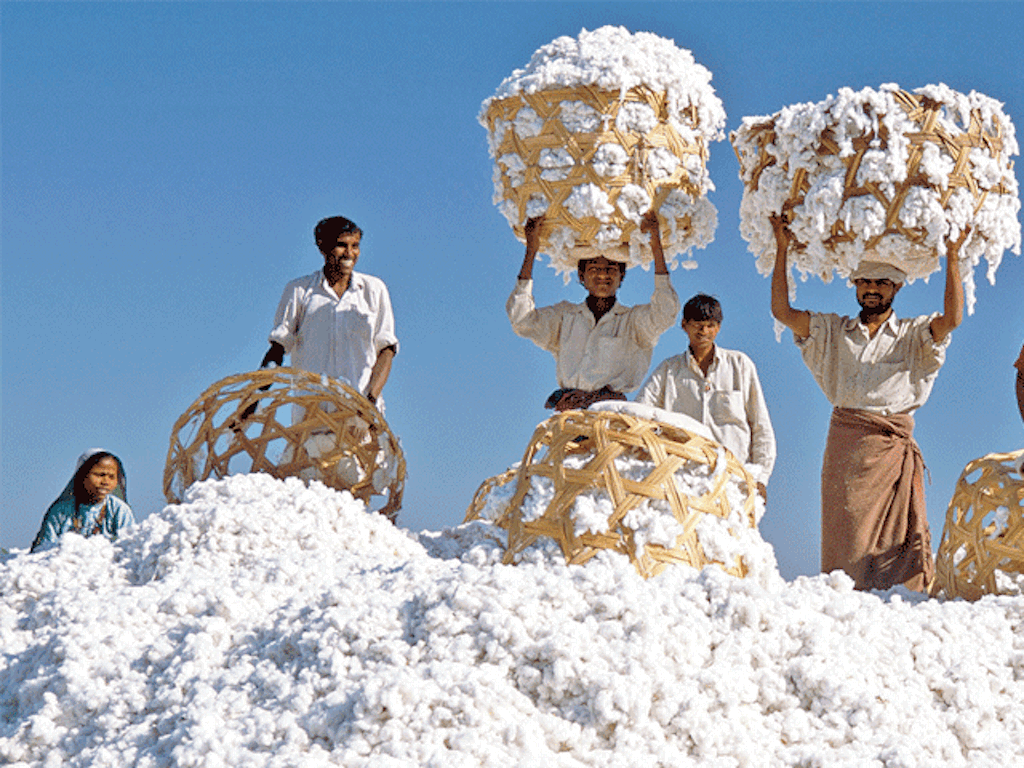
The Indian textile sector has begun to voice alarm about rising cotton prices in both international and local markets, with some even speculating that the natural fibre is being stockpiled.
Southern India Mills Association (SIMA) Chairman Ravi Sam urged for actions to stabilize cotton prices in a memorandum to Prime Minister Narendra Modi, citing the country's starting stockpiles of over 100 lakh bales (170 kg apiece) this season (October 2021-September 2022).
Cotton Production Is Higher This Season
Cotton output is expected to be higher this season, with 360 lakh bales compared to 353 lakh bales, according to cotton trade. SIMA's worry stems from the fact that Tamil Nadu accounts for half of the country's total cotton consumption.
Prices have soared to a record high of Rs66,000 per candy (356 lb) of ginned cotton as the fresh cotton harvest has begun to flood domestic markets. During the weekend, raw cotton modal prices (the rates at which most trades occur) at Gujarat's Rajkot agricultural produce marketing committee (APMC) yard jumped to Rs7,625 per quintal.
Currently, modal rates in Karnataka's Bijapur APMC have surpassed Rs8,600. Cotton prices have jumped to a 10-year high of 117.99 US cents a pound (Rs69,950 per candy) on the New York Mercantile Exchange, as output is low this year and supply has been impacted.
Led To Over 50 Percent Increase In Cotton Prices In 2021
According to the US Department of Agriculture, world-ending stocks and exports are expected to fall this year, while consumption is expected to rise. Cotton prices have risen by more than 50% since the beginning of 2021 as a result of this.
The industry is now pressing the Centre to urge the Cotton Corporation of India (CCI) to acquire the natural fibre from producers as a result of the rise in cotton prices. Cotton growers and traders, on the other hand, believe the CCI has little power to intervene in the market because prices are much above the minimum support price (MSP) of Rs5,726 per quintal for the medium staple type.
According to SIMA's Sam, a ten-year study of cotton price data suggests that the domestic industry only obtained one-third of the cotton produced, with the rest primarily purchased by the trade or the Cotton Corporation of India (CCI). Cotton prices are at their lowest from November to March, according to him.
"The government should consider price stability measures, and the CCI should establish regulations that allow the industry, particularly micro, small, and medium mills, to purchase more directly from it," the SIMA Chairman stated.
Speculators To Blame For The Uptick
In a letter to Prime Minister Narendra Modi, TEA President Raja M Shanmugam stated that CCI should be mandated to "defend the interests of farmers first and foremost, and should also work as a facilitator or catalyst to drive the expansion of the textile industry's value chain."
According to him, CCI needs to build a supply chain centre depending on demand in order to ensure that cotton is available quickly at the user's end. The corporation should be required to distribute cotton directly to textile mills owned by small, medium, and big businesses.
Speculators were driving up cotton costs, and CCI was boosting rates by Rs300-Rs1,000 per confection per day, according to Rikhab C Jain, Chairman, TT Group. In New York, he said there were abnormalities in domestic cotton futures and hedging.
He said that “speculators are attempting to profit at the expense of the whole cotton textile chain and industry.”
The cotton industry, on the other hand, claims that carryover supplies are at 75 lakh bales, with consumption and exports exceeding original predictions.
CCI's mandate is to only join the cotton market if prices fall below the MSP.
Yarn Prices Are Rising Further Than Cotton
"Cotton prices are growing, but yarn prices are soaring even faster. Yarn is in high demand both domestically and internationally. "All spinners are aggressively buying cotton to boost inventories," said Anand Poppat, a raw cotton, waste, and yarn seller in Rajkot.
Spinning mills, on the other hand, are unable to raise yarn pricing in response to rising cotton costs, according to a textile industry expert.
Another prominent trader, who did not want to be recognised, stated that spinning mills had 30-45 days of operating supplies and should be able to manage their costs despite rising cotton prices.
Cotton exports are in high demand, according to Poppat, notably in Bangladesh, which considers India to be a preferable choice. However, when speculators reduced their open positions, the current positive streak in the global market might be disrupted.
However, the scarcity of cotton and strong export demand lead to the positive trend continuing, albeit after a little pause.
Prices Are Likely To Drop
Though daily shipments are projected to exceed two lakh bales (170 kg apiece) in the coming days, Poppat predicts that cotton prices will remain constant to strong over the long term. Prices are anticipated to fall as arrivals pick up, according to SIMA Secretary-General K Selvaraju.
Despite the fact that merchants and experts predict that cotton exports would be lower this season, at roughly 50 lakh bales compared to 78 lakh bales last season, Poppat believes the crop quality is good this year and export demand will likely be more than expected.
According to Selvaraju, if exports are higher than expected, the textile sector might face a problem. The SIMA Chairman wrote to Modi as a result of this.
The sharp rise in crude oil costs is another factor driving up cotton prices. With Brent crude oil prices hovering around $83 per barrel, synthetic textile prices have risen in lockstep.
Increased pricing for oil-based synthetics are increasing demand and prices for natural counterparts such as cotton, according to Fitch Solutions Country Risk and Industry Research, a unit of Fitch Group.
















